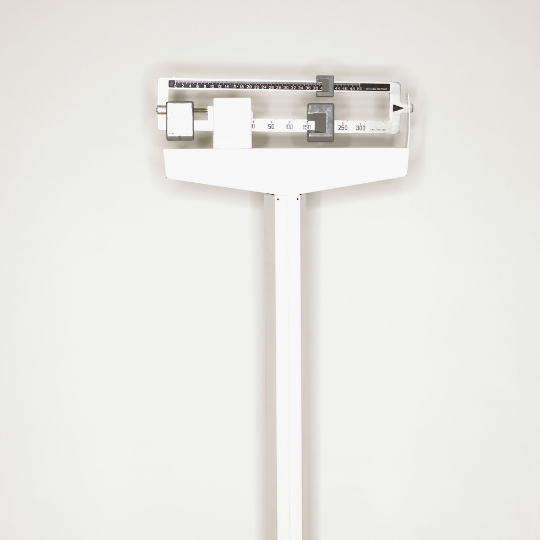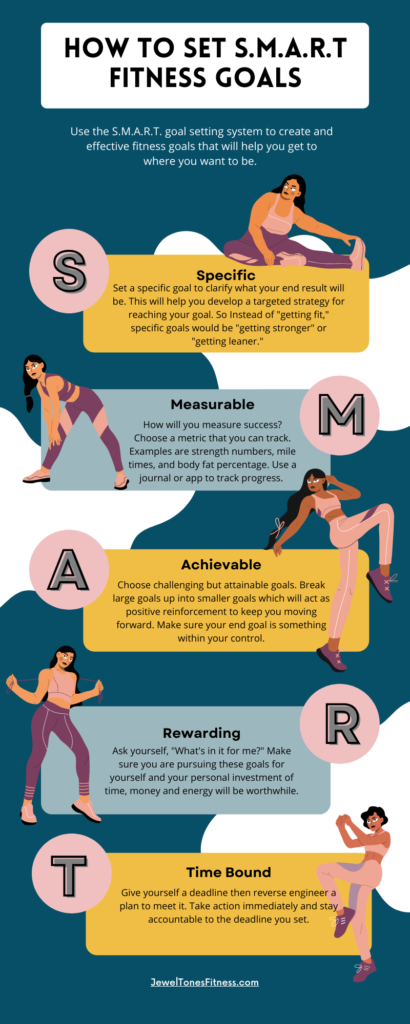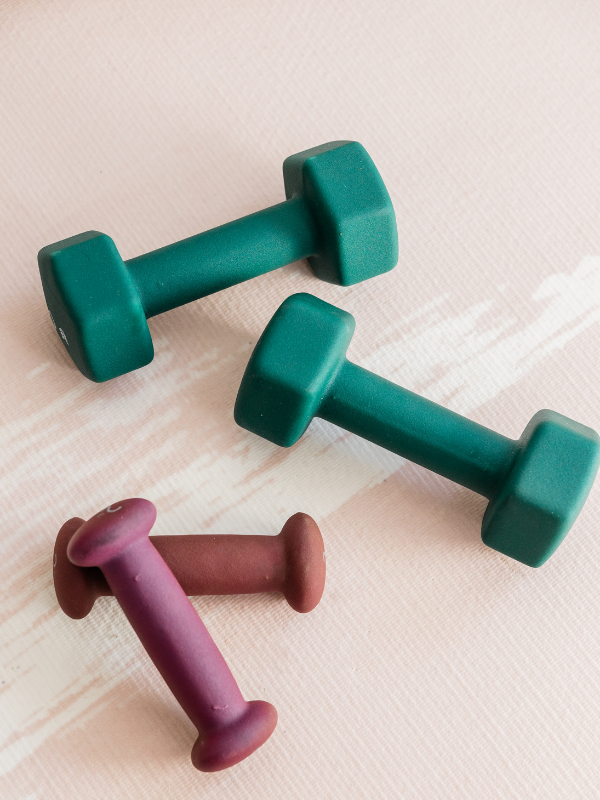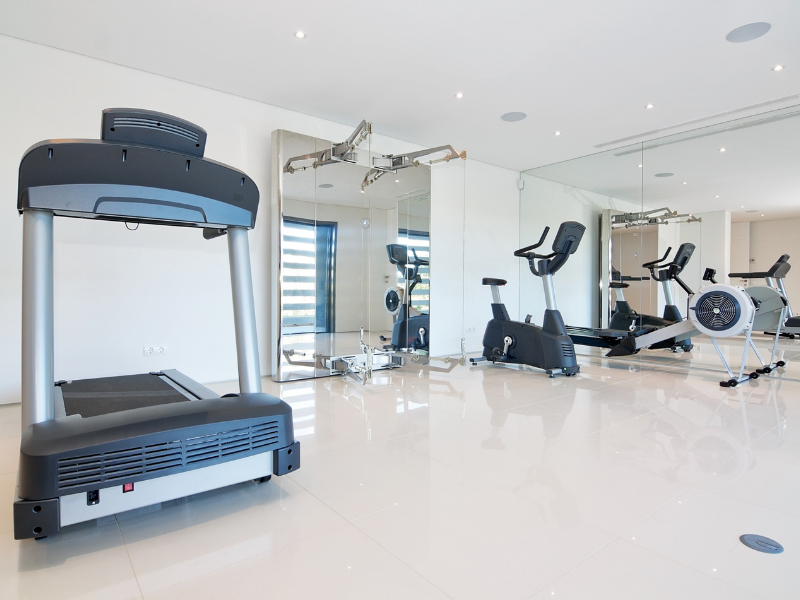Before I started setting SMART fitness goals, I would copy and paste my fitness goals from the last year onto my “New Year, New Me” spreadsheet right about this time.
What are your fitness goals? Are they something like getting fit, getting in shape, or getting healthy? I’ve written something similar in a journal or two. While these are worthy and hopeful goals, they’re not as effective as they could be. However, if you really dive into the details, they can be elevated to more effective goals that set you up for success.
In this guide, you’ll learn to apply the S.M.A.R.T. system when setting fitness goals to turn vague, ineffective goals into goals that get results. I’ve used this method to successfully increase my strength numbers, train for a race, and train for local fitness competitions, and you can use it to help get you where you want to be.

What Are S.M.A.R.T. Fitness Goals?
Originally developed as a framework for forming management goals, the S.M.A.R.T. goal-setting system can be an effective strategy for setting fitness goals that stick. The letters in this clever acronym are used with slight variations, but for our purposes today we will use the following interpretation:
S – Specific
M – Measurable
A – Achievable
R – Rewarding
T – Time-bound
Specific
I’ve uttered the phrase, “I want to get in better shape,” I don’t know, plus or minus a million times. Usually, I’ve been inspired to say this when prepping for some life event that’s supposed to be “fun.” Get a wedding invite – “I need to get in shape.” Booked a vacation that requires swimwear – “I need to get in shape.” Going to a high school reunion where I may encounter several ex-boyfriends or dudes that didn’t have the sense to even be an ex-boyfriend – “I NEED TO GET IN SHAPE.” But this phrase wasn’t magic, and just thinking it or saying it didn’t manifest my goal.
What does “get in better shape” really look like? Does it mean squatting 200 lbs or run one mile without stopping to take a call as an excuse to catch my breath? Does it mean losing weight and if I lose the 3 lbs. of water weight I gained from getting too friendly with the seasoning salt the night before, is it mission accomplished?
You can start to see the first problem with setting a goal like getting in better shape is it’s vague enough to mean anything. So how would I know when I’ve done it, or when to keep going?
Let’s add some specificity to improve that goal by asking what success looks like. Instead of get in better shape more specific examples would be:
- Get in shape – Get stronger becomes – Increase how much weight I can squat
- Get in shape – Get faster becomes – Run a half marathon
- Get in shape – move more – get 30 minutes of activity
Further building on the run a half marathon example we could say:
I want to get faster and run a half marathon.

Measurable
Next, we need to make our fitness goals measurable. This is what excites me most about applying this model when setting fitness goals. Fitness is a numbers game, and when setting goals, numbers are your friend.
Examples of Fitness Metrics:
- Distance: Running, Biking, Swimming or Rowing
- Strength Numbers: Bench Press, Back Squat, Deadlift
- Muscle Endurance: 30 Strict Pull-ups, 25 push-ups Unbroken
- Body Composition: Body Fat Percentage, Lean Muscle Mass
Bodyweight as a Metric

Let’s have a little sidebar about body weight. It’s probably the metric that’s most baked into the fitness goal conversation. However, it might not be the most useful metric as an indicator of fitness or health. If you increase your muscle mass with strength training, it’s possible that you could reduce body fat while technically weighing the same or more than a time in your life when you had less muscle mass. If you have a bodyweight goal, shift it to a goal centered around lowering your body fat percentage. Basically, B.M.I is trash.
Making Our Example Measurable
Using the example of running a half marathon, the number is right there. You would need to be able to run 13.1 miles, or 21K if you fancy. Increasing mileage is your unit of success and it makes progress towards your goal easy to track. As you increase your mileage in training sessions you will be closer to reaching your goal. We can add an additional metric this goal and include a time cap. This adds another layer of specificity to your end result. So let’s say your goal is now:
I want to get faster and run a half-marathon in 2:20 or less.
Tracking Your Progress
Tracking your progress is key to motivation. It’s all in the numbers. You will be able to see that your run distances are getting longer or your run times are getting shorter. This proof of your progress can motivate you to keep going. Additionally, it allows you to see what is and isn’t working, so you can adjust your strategy. Use a journal, spreadsheet, or fitness app to track your progress towards your goal. The platform doesn’t matter as long as it is something you will actively use.

Achievable
This step is going to require some introspection. Fitness goals should challenge you, that’s part of what makes them so rewarding in the end. Plan to push yourself, mentally and physically, but if a goal is ultimately impossible, you are setting yourself up for failure and disappointment.
Break Down Larger Goals
If your goal is to run a half-marathon, but you get winded walking the aisles of your local Target, you don’t have to give up on that as your ultimate goal, just shift it in your timeline. Break up the overall goal of running into smaller goals, that will get you there. As you go through this series of goals, be sure to apply the SMART framework to each of them. Here’s what a series of smaller goals could look like:
Walk 3 miles > Run 1 mile > Walk Run a 5K > Run a 5K > Run a 10K> Run a Half-Marathon
Each of the smaller goals could be further broken down into tinier micro-goals as well.
Personal Inventory
Do an inventory of where your fitness is at and use this information to determine if your goal is realistic. Some questions to ask yourself when determining if your goal is attainable are:
- What is my current level of activity?
- Does the time commitment fit my current lifestyle?
- Are there any injuries that may prevent me from meeting my goal?
- Do I need the support of my family?
- Can I financially afford to take this on?
- Potential costs: Personal Trainer, nutritionist, gym membership, athletic wear, coach, commute, monthly app subscription
- Am I in control of achieving my goal?
Honor where you are and be honest when answering these questions.

Rewarding
No one else can go out and run a mile in your body, or swing some battle ropes around for you during lunch, leaving you unable to grip a ballpoint pen in your afternoon meeting. You’re the one that will be investing the time, sweat, and, hopefully minimal, tears in bringing these goals to fruition.
You’ll most likely have to make sacrifices to take on these new goals, make sure the sacrifices are worthwhile.
Is The Goal Worthwhile?
- Why is achieving this goal important to me?
- What is the cost of not reaching this goal?
- What’s in it for me?
- How will achieving this goal increase my happiness or make me a better version of myself?
Making change, specifically physical change, can be a grind. The answers to these questions are what will motivate you to overcome setbacks and keep going on the days you just don’t want to.
If you are setting a goal based on pressure from your spouse, or your mother, or society, it might not feel worth the sacrifice. If the goal doesn’t feel worthwhile, to you personally, it will be harder to keep making progress towards it.
Celebrate Small Wins
Speaking of rewards, make sure to celebrate wins on the way to the big goal. Not all wins are big wins, but even small wins can serve as positive reinforcement to keep you motivated. if you’re staying consistent and making progress that’s worth celebrating.

Time-Bound
Finally, your fitness goals need a target date. Without this, it’s a lot easier to say you’ll start working towards your goals tomorrow, next Monday, or next week. A finite amount of time tied to accomplishing your goal creates an environment where the motivation to get started and keep going is built in. If there’s only a certain window of time to get it done, you better get moving. Give yourself a deadline to help stay focused, and be accountable to that date.
Parkinson’s Law
Remember the deadline must be realistically based on your lifestyle and current level of fitness. However, you should also be careful not to create a deadline that stretches too far into the future. British historian, Cyril Northcote Parkinson, published a theory known as Parkinson’s Law. According to this theory, work expands to fill the time available for completion.
If I give myself 6 months to train for a half-marathon, I will eat up every second of that time. I can be really comfortable and take off a week here or there, each time making it harder to re-commit to the end goal. Or, I could set a 3-month deadline, which is doable, but it’s going to push me to commit daily to make my end goal happen.
Do Your Research
How do you know how much time you need? Do a little research based on your goal. There are a wealth of resources online: blogs, YouTube channels, and fitness platforms. Find a couch to 10K program or a linear strength training program. Invest in an app that features training programs. If it’s in your budget, hire a personal trainer, coach, or nutritionist. Work with them to develop a plan to reach your goals. Be cautious of following training programs developed by people that don’t have the expertise or experience to give fitness advice.
If we add the final piece of this technique to our half-marathon example we would end up with something like this:
I will run a half marathon (13.1 miles), by April 5th.
Final Thoughts
You learned how to create SMART fitness goals to up your chances of success. As a reminder, here are some SMART Fitness goal examples:
Bad/Ineffective
Get Stronger
Get Leaner
Excercise More
Better
Increase Max Back Squat
Reduce Bodyfat to 20%
Get at least 30 minutes of activity 5 days a week
Best
Back Squat 200lbs. by March 1st
Reduce Bodyfat to 20% by June
Log 60 workouts of 30 minutes or more within the 90 days

You’re not writing a book or organizing your cabinets, you’re making physical change and your body has its limitations. Make adjustments when you need to. If you develop shin splints, for example, you may need to push out your deadline.
Be kind to your body. Be sure to do the maintenance to keep it going during this endeavor. Build in rest days and active recovery days, drink enough water, fuel your body with whole foods, and take time to stretch and work on your mobility.




Leave a Reply